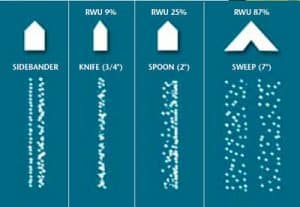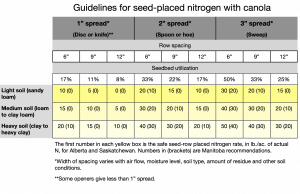Fertilizer can damage seed and seedlings. For higher seed survival, the safest move is to put no fertilizer in the seed row. However, canola seedlings often benefit from a starter rate of phosphorus, especially in cool soils.
In soils with low to medium levels of phosphorus, put 15 to 25 lb./ac. of P2O5 (~30-50 lb./ac. of monoammonium phosphate, for example) in the seed row. Soil tests will often recommend a higher rate of phosphorus for canola, so the balance is best added into the fertilizer blend placed outside the seed row.
How does fertilizer damage canola seed and seedlings?
The risk of seed-placed fertilizer comes from the nitrogen component of ammonium phosphate, ammonium sulphate and all nitrogen fertilizers. Ammonia can damage seedlings through direct toxicity while nitrate desiccates seedlings through the salt effect. These salts, when dissolved in soil water, have an osmotic effect that can hold back moisture from germinating seeds and seedlings. Damage increases with lower soil moisture.
Canola is sensitive to both the salt effect and direct toxicity. That is why, when it comes to safe rates of seed-placed fertilizer, there is no distinction made between products containing straight ammonium and those containing a mixture of ammonium and nitrate nitrogen.
Nitrogen products with a polymer coating (e.g. ESN) can allow for higher safe rates of seed-placed nitrogen by lowering the concentration of ammonia in contact with the seedling. Don’t put anhydrous ammonia in the seed row.
Potassium fertilizers, which have a high salt index, can also damage seedlings and are best kept out of the seed row. Canola has a much lower tolerance to seed-placed potassium than cereals.
Test the safety of seed-placed rates
To test the effect of seed-placed fertilizer, turn off seed-placed fertilizer runs for a few 100-foot strips. Mark these areas and then go back and do plant counts early in the season to compare treated and untreated strips.
NITROGEN: Factors that influence risk
Soil texture
The lighter the soil texture, the higher the risk to emergence damage and yield loss. Sandier soils are more risky than clays. Clay soils hold more nitrogen in the ammonium (NH4+) form. In sandy soils, more ammonium converts to ammonia (NH3), which is the form that causes seed and seedling damage because it is more toxic to plant tissues.
Seedbed moisture conditions at seeding
With moist soil conditions, water dilutes the concentration of nitrogen molecules around the seed and seedling. Water also disperses nitrogen molecules throughout the soil, reducing concentrations around the seed. In dry conditions, seed-placed nitrogen fertilizer tends to produce higher concentrations of ammonia and ammonium that can damage young seedlings. Seed-placed nitrogen rates should be lowered when conditions are drier than normal.
Fertilizer source
Canola is sensitive to both the salt effect of nitrate and direct toxicity of ammonia. Anhydrous ammonia (NH3) is the most damaging form and should never go in the seed row. Polymer coating or urease inhibitors slow the release of ammonia and ammonium from urea, which can allow for higher safe-rates of seed-placed urea.
Application rate
The higher the nitrogen rate, the higher the risk of emergence damage and yield loss resulting from lower plant counts.
Crop type
Generally, small seeded crops such as canola are more sensitive to seed-placed nitrogen. Do not use the same rates for canola as for wheat, which is less sensitive to ammonia toxicity and salt effect.
Soil pH
Safe rates will be even lower in fields with high pH soils. At higher pH, more of the nitrogen from urea is in the free ammonia form (NH3) vs. ammonium (NH4+). Ammonia is more damaging.
Seed-bed utilization
Seed-bed utilization (SBU) is the seed placement spread as a percentage of total soil area. Narrow rows and wide openers will increase SBU. A 1″ knife opener on 12″ centres has a low SBU of eight per cent, whereas a 3″ opener on 6″ centres will have a high SBU of 50 per cent. Tools with high SBU spread the same rates of seed and fertilizer over a greater proportion of the soil. This increases separation between seed and fertilizer, which reduces the risk from putting higher rates of fertilizer with the seed. (*SBU is also called row-width utilization (RWU), which is the term used in the graphic below.)
For more, check out Mooleki’s research on the maximum safe rate of seed-placed phosphorus fertilizer with different opener widths and row spacing.

TABLE: Guidelines for seed-placed nitrogen with canola

Important notes about the table:
- These guidelines show approximate safe rates of urea placed with the seed if seedbed soil moisture is good to excellent. Safe rates will be lower if soil moisture is lower. If moisture conditions are dry, reduce the safe amount of seed row nitrogen by half.
- All rates are in pounds of actual N per acre. Divide by 0.46 to get pounds of urea (46-0-0) per acre.
- When selecting seed placed nitrogen rates, note that the rates in Table 1 are IN ADDITION to the rates seed-placed MAP (11-51-0 or 12-52-0). MAP is usually safe at rates below 40 lb./ac. of product, or 20 lb./ac. of actual P2O5. Some growers also use diammonium phosphate (DAP) for starter phosphorus, but this form has a higher nitrogen component. Safe seed-placed rates for DAP will be slightly lower than for MAP.
- Numbers in brackets are safe rates for Manitoba. The first number is for the rest of the Prairies. This suggests that there is a line at the Manitoba border where canola suddenly becomes more sensitive. Of course this is not true. This distinction is based on soil characteristics. Manitoba soils tend to have high soil pH, and high levels of free lime or carbonates. Under these conditions, urea tends to release more of its nitrogen in the free ammonia form (NH3), which is more damaging than the ammonium form (NH4+). While more common in Manitoba, these conditions are not exclusive to Manitoba. Average pH in Manitoba is not much different from many other regions of the Prairies.
Canola Encyclopedia on nitrogen placement
PHOSPHORUS: Factors that influence risk
Phosphorus supply during the first two to six weeks of canola growth is critical to achieve optimal yield. Given that soil supply is reduced under wet, cold conditions, canola benefits from a seed-placed supply of fertilizer phosphorus. Cold soil decreases phosphorus solubility and diffusion in the soil solution, slowing phosphorus movement to roots and root uptake rates.
A seed-placed rate of 15 to 20 lb./ac. of P2O5 (~30 to 40 lb./ac. of monoammonium phosphate, or MAP) strikes a balance between seed proximity and seed safety. At that rate, fertilizer prills or droplets will be close enough for each seedling to access the supply. Good moisture and higher seed-bed utilization reduce the risk.
Formulation: Diammonium phosphate (DAP) has a higher nitrogen component than MAP, so safe seed-placed rates for DAP will be slightly lower than for MAP.
Canola Encyclopedia on phosphorus placement
POTASSIUM: Factors that influence risk
If canola requires potassium fertilizer, include potassium in the blend placed outside the seed row. Soils with higher clay and organic matter tend to reduce the risk from seed-placed potassium, but potassium deficiency is more likely to occur in sandy soils – which tend to increase the risk scenario for seed-placed potassium.
Canola Encyclopedia on potassium placement
SULPHUR: Factors that influence risk
Ammonium sulphate applied in the seed row along with monoammonium phosphate can increase seedling toxicity and reduce plant stand. Because sulphur uptake peaks later in the season, it doesn’t need to go in the seed row.
Canola Encyclopedia on sulphur placement
